
Gulliver's Travels: The Bioimaging Version
Berkeley Lab Scientists in CLASIC Study
Gulliver’s Travels: The Bioimaging Version
Just as Lemuel Gulliver, the narrator in the classic novel Gulliver’s Travels by Jonathan Swift, observed a wide range of human physical scales, from the very small Lilliputians to the very large Brobdingnagians, so too are bioscientists eager to observe both small and large-scale structures in living systems. This desire has given rise to the Gulliver Initiative: Multiscale Bioimaging from Molecules to Organisms. The idea is to combine the latest in imaging technologies and labeling methods to advance investigations into the chemical composition, physical properties and molecular interactions within complex samples of biological materials.
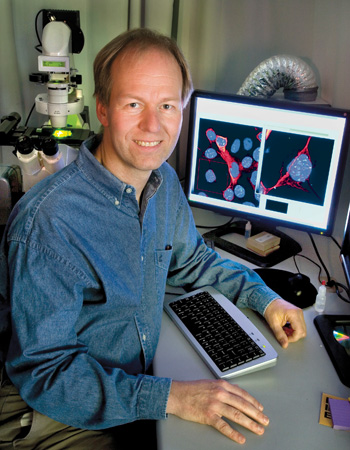
Damir Sudar, head of Berkeley Lab’s Bioimaging Group and Gulliver Conference workshop chair. photo by Roy Kaltschmidt, CSO
“Imaging techniques are dramatically accelerating biological research, revealing organizational and functional details at all levels of spatial and temporal resolution, ranging from single molecules to whole organisms,” said Joe Gray, director of Berkeley Lab’s Life Sciences Division (LSD).
“Moreover, new chemistries and nanomaterials are enabling the assessment of molecular function across these resolution ranges. So far, though, analytical methods are not well integrated across scales. For example, it is difficult to see how molecular complexes visualized with atomic resolution technologies integrate into and contribute to the functions of cells and organs.”
However, he added, “By combining appropriate methods, it should now be possible to obtain highly synergistic information about biological material. Such a multiscale approach to bioimaging will be important for key research goals in bioenergy, bioremediation, and carbon sequestration, as well as areas related to human disease such as cancer and neuroscience.”
Towards this end, Gray and Jay Keasling, director of Berkeley Lab’s Physical Biosciences Division (PBD), are putting together the Gulliver initiative. To identify all interested participants and focus plans for the initiative, they organized the Gulliver multiscale bioimaging workshop, which was held on May 17-19, at the Mathematical Sciences Research Institute (MSRI). The workshop drew a blue-ribbon list of speakers, including Berkeley Lab director Steve Chu, and was a tremendous success, according to the workshop chair, Damir Sudar, head of LSD’s Bioimaging Group (BIG).
“The goals of the workshop were to survey some of the cutting-edge advances in microscopy, including novel directions that are still in development,” Sudar said.
“We were also looking to see how we might best accomplish the goals of the Gulliver initiative.”
Following welcoming remarks by Berkeley Deputy Lab Director Graham Fleming, 18 talks were presented over the next two days to attendees, both in person and across the nation via live webcast. The presenters came from leading research institutes both here and abroad, and the audience represented multiple federal, academic and private industry researchers. The talks covered a wide range of topics within the workshop’s bioimaging context. Among the highlights were keynote addresses by Chris Somerville, a PBD plant biochemist and director of the Carnegie Institution’s plant biology department at Stanford; Eva Nogales, a biophysicist with LSD who also holds appointments with UC Berkeley and the Howard Hughes Medical Institute (HHMI); and Gray himself.
Somerville’s keynote address discussed the prospects of multiscale imaging for bioenergy research. He focused on the challenges of imaging the cell walls of plants because finding a way to efficiently dissolve lignocellulose (the main component of plant cell walls) into fermentable sugars is a critical requirement for making liquid biofuels. Scientists need a much better understanding of such things as the fine structure of plant cell walls and how it controls lignocellulosic properties. This requires better imaging capabilities.??
“It’s kind of remarkable that lignocellulose is the most abundant organic molecule on the planet yet we really don’t know how it is made,” said Somerville. “Part of this is because the tools we’ve had to study it have been primitive, but with initiatives like this (Gulliver), we can rectify that.”
Nogales, in her keynote address, “Visualizing Life,” discussed the architecture, dynamics and interactions of large macromolecular complexes, particularly those involved in nucleic acid transactions and the cytoskeleton during cell division.
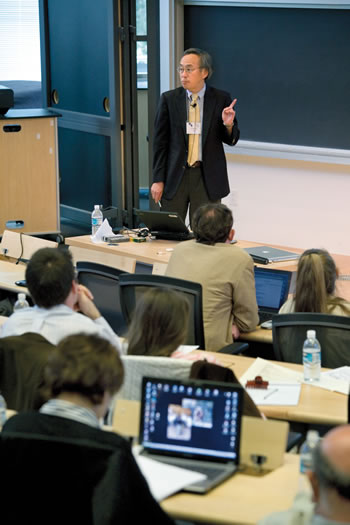
Lab Director Steve Chu was among the presenters at Gulliver
“The idea of being able to look at a biological system from the tissue, to the cell architecture and all the way down to the molecular details, using the various imaging technologies,(crystallography, tomography, etc.) just blows me away,” Nogales said. “It is a dream, but one that is in the process of coming true. For many biological studies, it will be wonderful to be able to move from one modality to another through the different scales of resolution.”
Gray’s keynote address was provocatively titled “Cancer, Looking at the Wild Life.” In this talk, he posed the question: what can we look at that will inform the management of the disease? Early detection technologies, such as the mammogram, have not reduced cancer mortality as physicians had hoped, the treatment strategies for most metastatic solid tumors are not cures, and the development of new anticancer drugs is time consuming, expensive and often unsuccessful. Gray argued that multiscale bioimaging could help turn this situation around.
“We need tools to establish protein structure and function, and tools to assess function in the cellular context,” Gray said. “We also need to understand the molecular mechanisms and extent of invasion and see the anatomic extent and molecular subtypes, and we need more efficient tools for structure-guided drug design.”
In summation, what is really needed, Gray went on to say, are “multiplex, molecular labeling techniques that work at all scales.” This is one of the critical goals of the Gulliver initiative.
Other highlights included a talk by Paul Alivisatos, director of Berkeley Lab’s Materials Sciences Division, on the use of nanocrystal molecules for biological sensing, a talk on capabilities of the new National Center for X-ray Tomo-graphy at the Advanced Light Source, by its director, Carolyn Larabell, and Director Chu’s talk on in vivo and in vitro single molecule imaging. Videos of these and other talks, as well as Powerpoint presentations can be viewed on-line at the Gulliver workshop website. Visit the url at http://www.lbl.gov/gulliver/ program_schedule.htm
Berkeley Lab Scientists in CLASIC Study
This summer, Berkeley Lab scientists are participating in one of the most comprehensive studies ever of how changes to the surface of the land, through agricultural practices such as plowing, crop rotation and irrigation, can affect atmospheric carbon dioxide concentrations. The study is part of the multi-federal agency Cloud and Land Surface Interaction Campaign (CLASIC), and the North American Carbon Program. It is taking place at the U.S. Department of Energy-operated Southern Great Plains research site in central Oklahoma, and runs from June 9 through June 30.
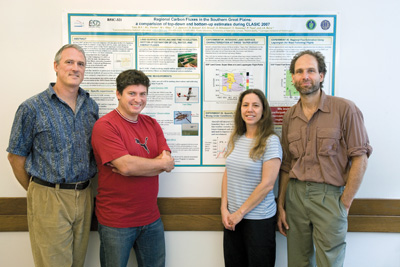
Berkeley Lab’s Atmospheric Radiation Measurement Program (ARM) team (from left) Bill Riley, Sebastien Biraud, Margaret Torn and Marc Fischer Photo by Roy Kaltschmidt, CSO
“The Southern Great Plains site is extraordinary for the kind of research we are doing because it features a mix of land use, both agriculture and oil refineries, and a flat landscape with consistent wind patterns that makes it easier to collect and analyze atmospheric measurements,” said Margaret Torn, a biogeochemist with the Earth Sciences Division (ESD), who leads Berkeley Lab’s participation in CLASIC. “Also, DOE has equipped the site with some of the best instrumentation in the world for conducting cloud and atmospheric radiation studies.”
Increased levels of atmospheric carbon dioxide (CO2), primarily from the refining and burning of fossil fuels, is a major contributor to a steady rise in global temperatures. According to the National Oceanic and Atmospheric Admin-istration (NOAA), the concentration of CO2 in our atmosphere today has not been exceeded in the last 420,000 years, and likely not in the last 20 million years.
The impact of rising atmospheric CO2 concentrations on global warming is a complex issue; to fully understand it require the connecting of a great many dots, including the dynamic interaction between land management and cloud lifecycles.
It was to help connect this set of dots that DOE initiated the carbon studies in CLASIC through its Atmospheric Radiation Measurement (ARM) Program. Three primary field research “supersites” have been established through the ARM Climate Research Facility (ACRF) program, including Southern Great Plains (SGP), which encompasses 55,000 square miles of land between central Oklahoma and southern Kansas. SGP features an array of remote sensing instrumentation that can collect continual data about clouds, aerosols and radiation.
Other members of the CLASIC team at Berkeley Lab, in addition to Torn, are William Riley, Marc Fischer and Sébastien Biraud. For the June experimental run, each member will take a 10-day shift. Their study will involve measurements of air samples collected through daily flights of specially equipped aircraft as well as from an instrument tower 60 meters in height, plus measurements from crop fields. The idea is to measure how atmospheric CO2 concentrations change in response to changes in land surface emissions.
“During the experiment, every afternoon starting at around 3:30 p.m., we will plan our flights and measurements for the next day,” said Torn. “We’ll gather at the aircraft early the next morning, evaluate flight conditions, make our decisions and prepare our instruments. Each flight will gather data for about four hours.”
In analyzing the data, Torn and her colleagues will measure ratios of carbon-14 (radiocarbon) to carbon-12 in the CO2 to partition the anthropogenic contributions (those derived from human activity) from the natural contributions.
“Natural sources of CO2 will contain carbon-14 in the background, whereas CO2 from the burning of fossil fuels will not, because all of the carbon-14 has long since decayed into nitrogen-14 while the fossil fuel source was underground,” Torn explained.
“We want to understand the influence of land cover, moisture gradients and atmospheric transport on CO2 fluxes,” she said. “Agriculture can act as either a CO2 source or sink, depending on how the agricultural land is managed.”
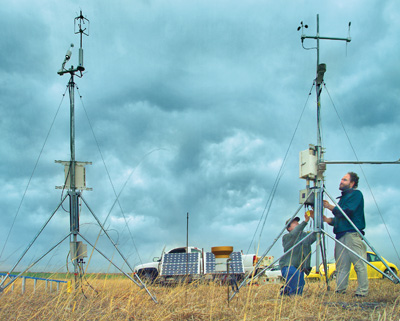
Marc Fischer prepares wind tests to track carbon in the Oklahoma wheatfields
Data from the Berkeley Lab studies will be integrated with the results of other CLASIC studies taking place during the June run at the SGP. The data will be entered into a central repository called the ARM Data Archive, and be made available on the Internet to scientists worldwide. Ultimately, the goal of CLASIC is to develop an effective local model of the dynamics between land surface and atmosphere that can be used elsewhere across the globe.
“We will never know all the variables as precisely as we would like, and we will always have some uncertainty, but this study represents a real opportunity to obtain a uniquely coherent and complete data set that can be used to develop models, tools and approaches we can apply to other geographic areas,” Torn said.
Other federal agencies contributing to CLASIC, in addition to DOE, are NASA, NOAA, and the U.S. Department of Agriculture (USDA). Other participating national laboratories, in addition to Berkeley Lab, are the Pacific Northwest National Laboratory, which is coordinating the June study, and the national laboratories at Brookhaven, Argonne, Los Alamos and Oak Ridge.
Programmer by Day, Six-Legged Robot Inventor on the Weekend
It wasn’t your typical county fair. Amid the catapult competition, five-foot Russian submarine, junkyard jet, and electric giraffe, Berkeley Lab’s Michael Cipriano unveiled a six-legged robot that scuttles about like a giant insect. He also showed off another robot designed to automatically detect and extinguish fire (or, more accurately, a single candle).
It was all part of the second Annual Bay Area Maker Faire, which was held May 19-20 at the San Mateo Fairgrounds. The event, established by Make magazine, showcased outlandish engineering and science projects made by people who like to cobble together gizmos from random stuff they find in their garage, basement, or on the internet. Cipriano was right at home.
“I’ve always been interested in making things, figuring out how they work, and getting them to do what I want them to do,” says Cipriano, a bioinformaticist and software developer in the Lab’s Physical Biosciences Division. “I’m very interested in robotics, electronics, and automation.”
He’s been building robots with the help of his girlfriend for the past two years. They’re part of a growing subculture of robot hobbyists. The Maker Faire, which was sponsored by such big companies as Microsoft, Yahoo!, and Google, drew about 400 inventors and their whirring and beeping creations. It also attracted an estimated 40,000 gawkers who came to see what happens when creative minds and spare parts collide.
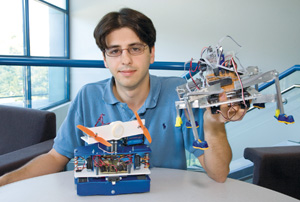
Cipriano with his six-legged, scuttling, fire-extinguishing robot
Cipriano is also a member of the Homebrew Robotics Club, a Bay Area group of robot enthusiasts that meets monthly at NASA Ames Research Center. They use old VCR motors, the odd wheelchair motor, computer chips, aluminum, and mechanisms from remote-control cars to make robots of all shapes and sizes.
It isn’t kid’s stuff, however. Cipriano’s insect-like robot is equipped with sensors on each foot that enable it to “feel” when it’s about to walk off the edge of a table. And his fire-extinguishing robot has two sensors to help it zero in on flames. One sensor detects a very specific bandwidth of light that matches the light given off by fire, the other sensor is a passive infrared motion detector that detects heat.
The Maker Faire is just one stop on the do-it-yourself robot circuit. Cipriano is taking his fire-extinguishing robot to the 2007 RoboGames, held this weekend in San Francisco. He’ll pit his creation against other robots in a race to find and douse a candle hidden in a mock 64-square-foot house. He’d also like to participate in an upcoming RoboMagellan competition, in which bots must traverse an outdoor course using a variety of technologies such as GPS, compass modules, and infrared, laser, and ultrasound sensors. Winning the competition will require innovation and perhaps a eureka moment or two, but that’s nothing new to Cipriano.
“Every time I see a robot that someone has made, I get a million new ideas,” says Cipriano.
Lab Hosts Low Carbon Fuel Symposium
In another indication that Berkeley Lab is becoming the place to tackle global warming issues, the Lab hosted a symposium on May 18 that focused on ways to reduce greenhouse gas emissions from the transportation sector. The International Low Carbon Fuel Symposium was attended by Governor Arnold Schwarzenegger, Lab Director Steve Chu, and more than 100 scientists, industry representatives, and policymakers from around the world. The symposium was sponsored by the International Council on Clean Transportation.
“We chose to hold the symposium at Berkeley Lab because we believe the Lab, through its new Energy Biosciences Institute, will be instrumental in creating the fuels that will power our economy under the Low Carbon Fuel Standard,” said Dan Skopec, undersecretary of the Cali-fornia Environmental Protection Agency.
At the symposium, Schwarzenegger discussed the Low Carbon Fuel Standard, which he established in January. It orders a reduction in the carbon intensity of California’s vehicle fuels by at least 10 percent by 2020.
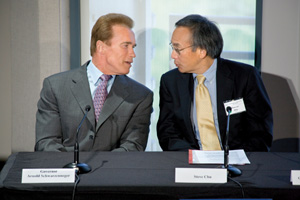
Governor Arnold Schwarzenegger and Lab Director Steve Chu at the Low Carbon Fuel Symposium hosted by the Lab
“We can protect the environment, slow global warming and stimulate a new economy of low-carbon fuels all at once,” Schwarzenegger said. “The Low Carbon Fuel Standard is our best weapon against rising gas prices. A vibrant market in alternative fuels and alternative vehicles gives consumers choices.
“This is our race to the moon,” added Schwarzenegger. “And like that race, this too would be ‘one giant leap for mankind.’ This is the challenge of our generation, and we will meet it with innovation, technology and with a commitment that matches the greatest pioneers in our history. This is what California is all about.”
Steve Chu also voiced his support. “I’m confident that California will become the leader in developing government policies, science, and technology that could lead to innovations,” Chu said. “These innovations will provide a path to the nation and the world in how we can develop the clean, sustainable solution for the worldwide energy policy.”
These speakers were followed by three panels that explored various aspects of low carbon fuel. The first panel, moderated by Skopec, discussed the implementation of the Low Carbon Fuel Standard in California and beyond.
As part of this panel, Alex Farrell, an assistant professor in UC Ber-keley’s Energy and Resources Group and a guest scientist in the Lab’s Earth Sciences Division, discussed proposed methods for measuring and tracking greenhouse gas emissions. He also presented a series of scenarios illustrating how different technologies can meet the Low Carbon Fuel Standard.
“California has more than enough capacity now to meet a
5 percent reduction in carbon emissions by 2020,” said Farrell. “Innovation is the key to going way beyond a million alternative fuel vehicles on the road by 2020. We need to change behavior and technologies to reach this goal.”
Berkeley Lab View
Published once a month by the Communications Department for the employees and retirees of Berkeley Lab.
Reid Edwards, Public Affairs Department head
Ron Kolb, Communications Department head
EDITOR
Pamela Patterson, 486-4045, pjpatterson@lbl.gov
Associate editor
Lyn Hunter, 486-4698, lhunter@lbl.gov
STAFF WRITERS
Dan Krotz, 486-4019
Paul Preuss, 486-6249
Lynn Yarris, 486-5375
CONTRIBUTING WRITERS
Ucilia Wang, 495-2402
Allan Chen, 486-4210
David Gilbert, (925) 296-5643
DESIGN
Caitlin Youngquist, 486-4020
Creative Services Office
Berkeley Lab
Communications Department
MS 65, One Cyclotron Road, Berkeley CA 94720
(510) 486-5771
Fax: (510) 486-6641
Berkeley Lab is managed by the University of California for the U.S. Department of Energy.
Online Version
The full text and photographs of each edition of The View, as well as the Currents archive going back to 1994, are published online on the Berkeley Lab website under “Publications” in the A-Z Index. The site allows users to do searches of past articles.
Flea Market is now online at www.lbl.gov/fleamarket
Shining a Light on the Dark Matter of the Genome
The Secrets of the Fruit Fly’s Heterochromatin
Remember “junk DNA?” It’s what biologists called the highly repetitive, gene-poor DNA in regions of the chromosomes known as heterochromatin. Like dark matter in the universe, the true nature of heterochromatin was unknown.
“Junk” will be heard less often after the appearance, in today’s issue of Science, of two papers reporting the nearly complete assembly, mapping, and functional analysis of Drosophila melanogaster — fruit fly — heterochromatin.
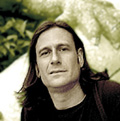


Gary Karpen, Chris Smith, Susan Celniker
“Most researchers thought heterochromatin had little or no function, because it appeared to lack the protein-coding genes that occur so richly in the chromosomes’ more accessible and better-studied euchro-matin,” says Gary Karpen of the Life Sciences Division (LSD), an adjunct professor of cell and molecular biology at UC Berkeley and head of the Drosophila Heterochromatin Genome Project, whose members wrote the Science reports.
“Drosophila is ideal for studying genomics for many reasons, and especially for studying heterochromatin,” says LSD’s Susan Celniker, a longtime member of the Berkeley Drosophila Genome Project (BDGP). “Over a third of the total DNA in a fruit fly is heterochromatin.“ The first “substantially complete” genome sequence of Drosophila, published in Science in March, 2000 by the BDGP and Celera Genomics, was actually far from complete.
“We devoted our efforts towards finishing the euchromatin, leaving the part of the sequence rich in repeats, the centromeric and telomeric regions, until later,” Celniker says. In a typically bow-tie-shaped chromosome, the centromere is the knot. It plays a crucial role in controlling chromosome duplication during cell division. Telomeres are a chromosome’s end-caps; they help prevent the accumulation of genomic damage.
Both heterochromatin and euchro-matin are sequenced using a method called whole-genome shotgun sequencing. “We grind up whole flies and produce libraries of DNA fragments,” says Celniker. “Contiguous lengths of sequence are assembled by matching overlaps of these fragments. With euchromatin, large, single-copy fragments practically assemble themselves.”
Repeat-rich heterochromatin is more difficult. Moderately repeating fragments are assembled by comparing numerous copies. The assembly is checked by matching it to clones of longer sequences.
The fly’s heterochromatin turns out to contain over 200 protein-coding genes, plus genes for non-protein-coding RNAs, such as small RNAs that neutralize transposons (transposable elements) — DNAs similar to viruses. Transposons hop around the genome and are capable of disrupting gene function.
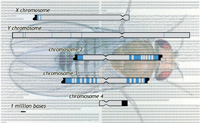
The heterochromatin of Drosophila’s centromere extends toward the center of the chromosomes from the gene-rich euchromatin (black). The sequenced regions are shown in blue. The gray regions are unsequenced “seas” of short repeats.
“Historically it was called junk. We set out to see if there was any information in that junk,” says Chris Smith, formerly in Berkeley Lab’s Life Sciences Division and now an assistant professor of bioinformatics at San Francisco State University. “We used a pipeline of computer programs to analyze the raw sequence data, in search of genes.”
The protein-coding genes they found are organized differently from genes in euchromatin, suggesting they are regulated differently. They also found single-copy genes for small noncoding RNAs, and pseudogenes — truncated inactive genes, likely duplicates or no longer needed.
Most of the repeating DNA, says Smith, “is transposable elements that have been chewed up and fragmented. The heterochromatin is where transposons may be actively regulated — they go in, get stuck, and get chopped up.”
Smith uses the metaphor of dark matter to suggest heterochromatin’s significance. “We don’t know what holds the galaxies together, and the same is true of the genome. We hear too much about the ‘post-genomic era’ — it’s underappreciated that we don’t understand the genome yet.”
“Sequence finishing and mapping of Drosophila melanogaster heterochromatin,” by Roger Hoskins, Joseph Carlson, Cameron Kennedy, David Acevedo, Martha Evans-Holm, Erwin Frise, Kenneth Wan, Soo Park, Maria Mendez-Lago, Fabrizio Rossi, Alfredo Villasante, Patrizio Dimitri, Gary Karpen, and Susan Celniker, and “The release 5.1 annotation of Drosophila melanogaster heterochromatin,” by Christopher Smith, ShenQiang Shu, Christopher Mungall, and Gary Karpen, appear in today’s issue of Science.
In Nature, Proteins Sweep Up Nanoparticles
Deep inside a flooded mine in Wisconsin, scientists from several institutions including Berkeley Lab have discovered a world in which bacteria emit proteins that sweep up metal nanoparticles into immobile clumps.
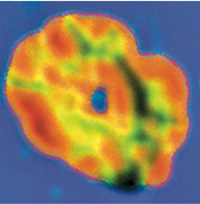
Secondary ion microprobe
The research, which appears in today’s issue of Science, reveals that the proteins travel far from the microbes that produce them and then amass metal nanoparticles into piles that are too large to be swept away by underground currents. Precisely how and why the bacteria undertake this bit of housecleaning remains a mystery, but it suggests that proteins could play a key role in bioremediation strategies designed to trap harmful metals such as arsenic, lead, uranium, and plutonium.
“We have found, in the environment, that cells release proteins and polypeptides which promote the aggregation of nanoparticulate metals,” says John Moreau, lead author of the study and a former Ph.D. student in UC Berkeley’s Department of Earth and Planetary Sciences.
Moreau conducted the research under the guidance of Jill Banfield, a principal investigator in the Earth Sciences Division, and a UC Berkeley professor in the Department of Earth and Planetary Sciences and in the Department of Environmental Science, Policy and Management. Other scientists involved in the research include Michael Martin and Benjamin Gilbert of Berkeley Lab, and Peter Weber and Ian Hutcheon of Lawrence Livermore National Laboratory.
They analyzed a biofilm rich in zinc sulfide that was collected from the water-filled mine. Using transmission electron microscopy at the Lab’s National Center for Electron Microscopy, they found that the zinc sulfide nanoparticles were arranged in dense aggregates. Such tightly packed metal sulfide formations are not new to scientists, but they do beg a question that remains unanswered: Why do the nanoparticles group together? Something so small should disperse throughout the mine. Instead, the metal nanoparticles form blobs that measure several microns in diameter. And these larger blobs anchor the nanoparticles in place. Stopping nanoparticles in their tracks, as this process does, could become a critical component of a bioremediation strategy, if only scientists understand how it works.
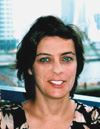
Jill Banfield
To explore this question, the team turned to the Lab’s Advanced Light Source and detected the characteristic signal of proteins in the biofilm. Next, to further zero in on this intriguing signal, they examined the sample using an extremely high-spatial-resolution imaging tool called secondary ion probe spectrometry, which is located at the Lawrence Livermore National Laboratory.
To their surprise, they found proteins and polypeptides embedded within the zinc sulfide nanoparticles. “We found that the mineral aggregates, which are produced as a consequence of microbial activity, actually contain a lot of protein,” says Banfield. “If we understand what causes nanoparticles to aggregate, we have the potential to control their mobility in the subsurface by adding constituents that drive aggregation.”
Emergency Preparedness Week Lessons:Learn from Catastrophe, Be Prepared
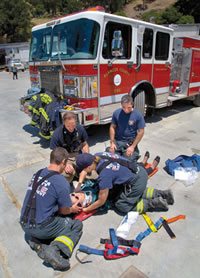
Alameda County firefighters tend to volunteer “victim” Genevieve Pastor-Cohen and prepare her for medical helicopter transport (clockwise from left): Pat Mehew, Pep Bauman, Mark Garcia, Armigh Carrizalez
It was a week to think about emergencies and disasters. Not the happiest of topics, to be sure, but Berkeley Lab’s first Emergency Preparedness Week June 4-8 was all about survival — as a lab, and as individuals.
“We’ve had a number of catastrophic events over the last several years,” said Howard Hatayama, the Lab’s Division Director for Environ-ment, Health and Safety, at the week’s opening preparedness fair. He could have been referring to everything from an earthquake and deadly firestorm to terrorist attacks and random shootings. “We all know how difficult it is to learn the lessons of those events.
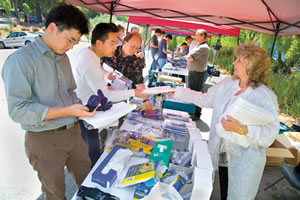
Kimberley-Clark vendor Donna Fuller hands out items to visitors at her exhibit table during the June 4 Emergency Preparedness Fair.
“One of the big reasons to have a week like this,” he continued, “is to remind us of those lessons, to learn them and practice them to be sensitized to surviving emergency events.”
Gov. Schwarzenegger was so impressed that he sent his deputy director for the response and recovery division of the state Office of Emergency Services, Paul Jacks, to deliver a proclamation of support. “California’s scientific community is one of the hardest working and most innovative in the world, and nowhere is this better displayed than at the Lawrence Berkeley National Laboratory,” he said. “Here, men and women are not only prepared to answer our nation’s most pressing and sensitive scientific questions; they are also personally prepared to meet the challenges of both everyday and emergency situations.
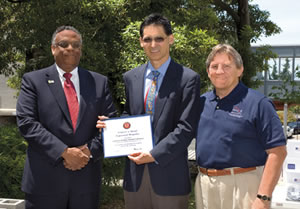
(Left to right) Paul Jacks of the Governor's staff presents a state proclamation to EH&S Division Director Howard Hatayama at the Emergency Preparedness Fair, as Lab Emergency Services Manager Rocky Saunders looks on.
“Your exemplary commitment to emergency preparedness keeps us safe and is worthy of emulation.”
After the fair, the week included a rescue drill by the California Shock Trauma Air Rescue Service, the Lab’s own annual “duck-cover-and-hold” drill, and two outside speakers who shared information on personal and earthquake preparedness.
The Laboratory’s own Emergency Operations Center (EOC) at the fire house was activated as part of Wednesday’s earthquake drill, but this time the planning scenario was much different, and even more contemporary. Emergency Services Manager Rocky Saunders outlined a simulated shooter-and-hostages situation and asked the two dozen members of the emergency team to plot strategy on saving lives and securing the facility. With observation and advice by UC Berkeley police Lt. Adan Tejada and Livermore Lab emergency specialist John Richards, the group of Lab volunteers rehearsed their roles in communications, logistics, operations, plans and intelligence, and finance.
It was all part of learning the lessons and practicing them, said Hatayama, who managed the EOC exercise. It’s the next best thing to having no emergencies at all.
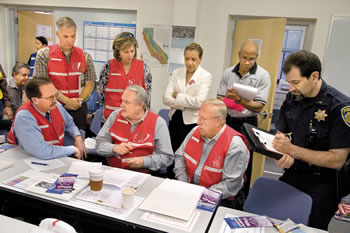
The Operations group at the Lab's Emergency Operations Center discuss strategy on responding to a crisis as DOE officials look on (bottom row): Peter Lichty, Steve Black, Jim Breckinridge, and (top row) Richard DeBusk, Nancy Rothermich, DOE Berkeley Site Office Manager Aundra Richards, Livermore observor John Richards, and UC Berkeley police Lt. Adan Tejada
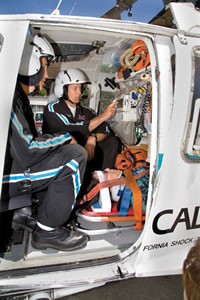
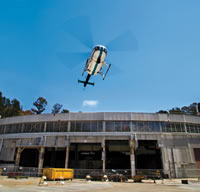 Top: Flight nurses Tim Castelli and Rich Ikerd position Pastor-Cohen in cockpit during CALSTAR rescue demonstration
Top: Flight nurses Tim Castelli and Rich Ikerd position Pastor-Cohen in cockpit during CALSTAR rescue demonstration
Future Light: a look ahead with Roger Falcone
Roger Falcone, Director of the Advanced Light Source, grew up in New York City’s Queens, where he attended Jamaica High School. “It was a very diverse, public institution,” he says. “It wasn’t the Bronx High School of Science, but we had a powerful principal who made sure kids interested in science were tracked.”
At Princeton, Falcone was a physics major, but he loved engineering and spent most of his time in the Engineering School. When he heard a visiting lecturer from Bell Labs talk about ultrafast lasers, “That seemed terrific to me, and it set the stage for the rest of my professional life.”
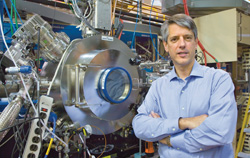
Roger Falcone, Director of the Advanced Light Source
After his Ph.D. and a fellowship at Stanford, Falcone joined the faculty of UC Berkeley in 1983, where he used powerful lasers to study the dynamics of materials. He became chair of the Physics Department in 1995, a post he held for five years. “It became clear I wasn’t going to have as much time to spend with the students in the laboratory tweaking knobs, so I began to look around for other research opportunities.”
Falcone worked as a guest at the ALS, then as a joint Lab-UCB appointee in the Accelerator and Fusion Research Division and later the ALS Division. At the time, Robert Schoenlein and Charles Shank were developing x-ray-pulse methods, which Falcone compares to capturing motion with a strobe light.
“An alternative way to slow fast motion is to have a fast movie camera, then play the movie back slowly. That was the technology that I was proposing. Bob and I joined forces.” Almost 10 years later, the ultrafast x-ray facility at beamline 6 that Falcone helped propose as an ALS user is now being commissioned under his directorship. Recently The View spoke with him about the future of the ALS and other scientific initiatives.
His immediate priorities
Falcone: The basis in the near term is the Strategic Plan, begun by Daniel Chemla and brought closer to completion under Janos Kirz (former ALS director and interim director, respectively). We call this program the renewal of the ALS — not just an upgrade, not a replacement, it’s really a renewal.
Our top priority is to hire excellent staff. We’re a facility that runs 24/7; we have 2,000 users who come from all over the world. More staff will allow us to serve more users, and productivity will increase.
Another priority is “top-off.” Right now, we inject current into the storage ring every eight hours. With top-off, we continually add electrons, maintaining a constant high level of current — which doubles the power that comes out of the ring, so in principle experiments could be done twice as fast. Top-off also increases brightness, for increased resolution. We expect top-off will be operable by the end of the year.
Other projects for renewing the facility include adding sextupole magnets to the lattice. The ALS was built 15 years ago, but a few technical advances — the top-off and these new magnets — will bring our technology up to the level of the newest machines being built in Europe.
Much of what we do here at the ALS is spectromicroscopy — “spectro” meaning we can tune the x-ray wavelength, and “microscopy” meaning very high spatial resolution. So we can see where things are, and what they are, and how they’re put together.
With PEEM3 (Photoemission Electron Microscope), we tune the x-rays to resonate with particular atoms, and then image the electrons that come off to nanometer-scale spatial resolution. Because we have to have aberration-corrected electron imaging, we have undertaken this in a coordinated way with the National Center for Electron Microscopy (currently developing TEAM, the Transmission Electron Aberration-Corrected Microscope).
Another beamline project is MERLIN (Millivolt Energy Resolution Line), for high-resolution, inelastic x-ray scattering. With inelastic scattering, the wavelength of the light that’s scattered is not the same as the wavelength that comes in. We understand the excitation modes of the material by looking at these shifts in energy.
That leads us into Wave One of our Strategic Plan. We have submitted proposals to DOE, and the projects we’re planning are called COSMIC (Coherent Scattering and Diffraction Microscopy) and MAESTRO (Microscopy and Electronic Structure Observatory). COSMIC will allow what we call lensless imaging.
With a normal light microscope you put something on the microscope slide and shine a light from beneath it, and then you have an objective lens that forms an image on your eyeball. But lenses are very difficult to make in the x-ray regime; there’s a limit to how good a resolution you can get, typically 20 to 50 nanometers.
If you want to look at higher resolution — atoms are spaced by a tenth of a nanometer — what you do is get rid of that objective lens. The scattered light has variations in intensity and phase imprinted on it. You use a computer to analyze the patterns and reform an image of the object. This is lensless imaging, and it represents the future of x-ray imaging at the atomic scale.
Vision for the future
Falcone: John Corlett and the folks in AFRD have submitted a proposal, which DOE is considering, to develop the technology for a new light source, a free-electron x-ray laser. We hope Berkeley Lab will be considered as the site, but what’s most important is to understand the scientific needs and then do the research and development needed to construct a really advanced machine.
The advantage as opposed to a synchrotron light source is that when electrons radiate coherently in a laser beam, you get about four orders of magnitude more electromagnetic power per electron. The downside is that, in a linear device, you usually get just one beam. So in thinking about a new generation machine, we plan to multiplex it.
The new machine would have a high repetition rate and a short-pulse capability, to resolve some of the absolutely fastest processes in nature. The machine we’re envisioning would have time-scales of a hundred attoseconds (billionths of a billionth of a second), the time-scale for electrons to correlate.
We have scientists at this Laboratory who are doing the kind of work that would take advantage of this machine, in the Chemical and Materials Sciences Divisions. We have the accelerator expertise in AFRD. The Laboratory really has the intellectual leadership here.
Roger Falcone’s enthusiasm for science education may have begun when he was a kid in New York and visited the set of “Watch Mr. Wizard,” Don Herbert’s live TV show. The conscious choice came later: in graduate school he weighed an offer from Bell Labs but decided to stick with a university job, because “teaching is a great profession to grow old in.”
Falcone and his wife, Patricia, an engineer involved in national security issues at Sandia National Lab in Livermore, live in Lafayette. When their children were in school, he recalls, “There was a huge community debate over the programs for gifted and talented students and how much to support them.”
Falcone ran for the local school board and became president. “We decided to have a program we called differentiated instruction, recognizing that every child needs special education of some sort, whether they are at advanced level or need extra support.” He learned that most elementary science teachers were not comfortable with science. “They didn’t understand what they were teaching. We decided to hire a science expert for every elementary school — someone trained in science who makes the students and the teachers more comfortable.” The program has been an extraordinary success.
Realizing that the overwhelming majority of California math and science teachers don’t major in those subjects inspired Falcone to become one of two faculty co-directors of UC’s CalTEACH program. Intended to produce a thousand new K-through-12 teachers every year from UC campuses, CalTEACH qualifies majors in science, engineering, and math for interim teaching credentials upon graduation — enabling them to get teaching jobs without having to go through an additional year or two of school. “We’ve engaged Berkeley Lab in this program,” says Falcone. “The Center for Science and Engineering Education has wonderful programs for supporting teachers during the summer and connecting them with scientists.” The Lawrence Hall of Science, where Falcone chairs the faculty advisory committee, also contributes with classes for potential teachers.
Such initiatives are part of what Falcone calls “the three metrics we’re judged upon — research, teaching, and service.” It’s a prescription not just for a university career, but for a full life. —Paul Preuss
Berkeley Lab Science Roundup
When Mold Attacks
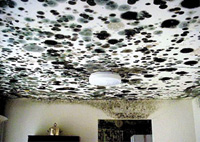
Studies show that mold in the walls and ceiling of homes substantially raises the risk of asthma and other respiratory problems and adds $3.5 billion to the annual national health bill.
Dampness and mold in buildings pose considerable public health risks and economic consequences in the U.S., according to a pair of recent Berkeley Lab studies. One paper by William J. Fisk, Quanhong Lei-Gomez and Mark J. Mendell, all from the Environmental Energy Technologies Division (EETD), concludes that building dampness and mold raised the risk of a variety of respiratory and asthma-related health outcomes by 30 to 50 percent.
“Our analysis does not prove that dampness and mold cause these health effects,” says Fisk. “However, the consistent and relatively strong associations of dampness with adverse health effects strongly suggest causation by dampness-related [pollutant] exposures.”
The second paper, by David Mudarri of the U.S. Environmental Protection Agency and Fisk, estimates that 21 percent of current asthma cases in the U.S. are attributable to dampness and mold exposure. “Of the 21.8 million people reported to have asthma in the U.S., approximately 4.6 million cases are estimated to be attributable to dampness and mold exposure in the home,” says the study.
Of Flies and Nematodes….

The National Human Genome Research Institute has awarded grants to study functional elements in the genomes of the model organisms D. melanogaster and C. Elegans.
The National Institutes of Health recently announced the first grants in a four-year, $57 million effort to identify the functional elements in the genomes of the fruit fly Drosophila melanogaster and the nematode Caenorhabditis elegans.
Several scientists in the Life Sciences Division are the principal investigators on two of the grant projects, while other members of the division are co-principal investigators on additional projects. The projects are part of the ENCODE program (Encyclopedia of DNA Elements) administered by the National Human Genome Research Institute (NHGRI). The fly and nematode projects are dubbed modENCODE, because they are studies of model organisms.
Susan Celniker is principal investigator and Roger Hoskins is co-PI of a project titled “Comprehensive Characterization of the Drosophila Transcriptome.” Gary Karpen is PI of a project titled “Genome-wide Mapping of Chromo-somal Proteins in Drosophila.” And research on the nematode C. elegans is represented by a project for which Abby Dernburg is co-PI.
The modENCODE project is an important part of the human ENCODE effort because functional elements in the human genome can only be studied in cultured cells, which limits understanding of complex integrative processes such as cell-cell communication. By contrast, nonhuman model organisms can be manipulated in vivo. These alterations may reveal the biological significance of the functional element.
….And Eucalyptus Trees and Red Algae
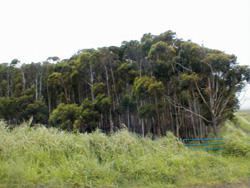
Stand of eucalyptus trees
To help harness the power of nature through DNA sequencing, the Joint Genome Institute recently announced the latest Community Sequencing Program (CSP) portfolio. These plant and microbial targets — most with implications for helping wean the nation’s dependence on fossil fuel — total some 21 billion nucleotides of DNA sequence capacity allocated to public projects submitted through the CSP for fiscal year 2008.
Among the highest profile of these projects, and largest, with a 600-million-nucleotide genome, is the eucalyptus tree genome, which is geared to the generation of resources for renewable energy. The second largest CSP project selected for 2008 is foxtail millet, which is a close relative of several prospective biofuel crops, including switchgrass. The third largest genome project to be undertaken in 2008 is the marine red alga Porphyra purpurea. The ocean plays a key role in removing carbon dioxide from the atmosphere with the help of marine photosynthetic organisms like P. purpurea.
Building a Better Magnetometer

Stamper-Kurn
Capturing the coldest atoms in the universe within the confines of a laser beam, UC Berkeley and Berkeley Lab physicists have made a device that can map magnetic fields more precisely than ever before. “This is not a bulk sensor for magnetic fields, but a precision magnetometer that can measure the magnetic field over small length scales, on the order of microns — a thousand times smaller than a millimeter — with a field sensitivity which is comparable to or better than modern scanning-SQUID microscopes,” said Lab materials scientist Dan Stamper-Kurn.
The researchers created their device by cooling a gas of rubidium atoms (rubidium-87) to a mere 50 nanoKelvin — 50 billionths of a degree above absolute zero — to create a so-called spinor Bose-Einstein condensate. This is a quantum fluid that manifests both frictionless flow, making it a superfluid, and also magnetization, as a ferromagnet. By taking repeated pictures of the gas and exploiting its magnetic properties, they were able to detect, within a quarter-second measurement time, magnetic fields as small as 1 picoTesla, 50 million times weaker than the Earth’s magnetic field.
JGI Sets ‘Gold Standard’ for Metagenomics
Also from the Joint Genome Institute: With the advent of more powerful and economical DNA sequencing technologies, gene discovery and characterization is transitioning from single-organism studies to revealing the potential biotechnology applications embedded in communities of microbial genomes, or metagenomes. The field of metagenomics is still in its infancy — the equivalent of the early days of the California Gold Rush, with labs vying to stake their claim.
Amidst the prospecting, the call has been issued for methods to separate fool’s gold from the real nuggets. Such a gold standard has now been provided through work led by the Joint Genome Institute with colleagues from Oak Ridge National Laboratory and IBM‘s T.J. Watson Research Center.
“DOE JGI and our collaborators have pioneered the use of DNA sequencing-based technologies to understand microbial communities through a combination of computational and experimental methods,” said Konstantinos Mavrommatis, who is a scientist in Berkeley Lab’s Genomics Division and a post-doctoral fellow in JGI’s Genome Biology Program. “We are now exploring ways to analyze metagenomic data to enable accurate classification of sequence fragments into their corresponding species populations.”
The Power of Wind Power

On May 31, the Department of Energy released its annual report on “U.S. Wind Power Installation, Cost, and Performance Trends 2006.” The primary authors are Ryan Wiser and Mark Bolinger from EETD, with contributions from fellow EETD scientists Galen Barbose and Andrew Mills. The report describes the rapid growth in U.S. wind power installations.
Most notably, the report concludes that U.S. wind power capacity increased by 27 percent in 2006; and that the U.S. had the fastest growing wind power capacity in the world in 2005 and 2006. More than 61 percent of the U.S.’s total wind capacity — over 7,300 Megawatts (MW) — has been installed since President Bush took office in 2001.
In 2006, for the second straight year, the U.S. led the world by installing 2,454 MW of wind power capacity, enough to power the homes in a city the size of Philadelphia. The U.S. produced roughly 16 percent of the worldwide wind market, followed by Germany, India, Spain, and China.
Gabor Somorjai Wins Priestley Award
Berkeley Lab chemist Gabor Somorjai has been awarded the 2008 Priestley Medal, the highest honor of the American Chemical Society (ACS). He becomes the sixth Berkeley Lab scientist to win the award which is named for Joseph Priestley, who reported the discovery of oxygen in 1774.
Somorjai, who holds a joint appointment with Berkeley Lab’s Materials Sciences Division and the UC Berkeley Chemistry Department, will receive his award at the spring 2008 ACS national meeting. The award citation reads, “For extraordinarily creative and original contributions to surface science and catalysis.”
An international authority on catalysis and widely recognized by his peers as the father of modern surface science, Somorjai has authored more than 1,000 scientific papers and three textbooks on surface chemistry and heterogeneous catalysis, and has mentored more than 300 Ph.D. students and postdoctoral fellows.
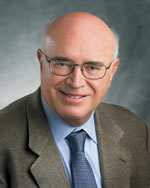 Gabor Somorjai
Gabor Somorjai
“A society’s standard of living can be measured by its knowledge of industrial catalysis,” Somorjai once said, referring to the fact that nearly all manufacturing processes involving chemistry start with a catalytic reaction between the surfaces of two materials. When Somorjai began his career, scientific data on the structure, composition and reactivity of surfaces, especially at the critical molecular level, was scarce.
According to at least one peer, he almost single-handedly established the molecular foundations of surface catalysis.
“Over the years, we developed a large number of techniques and instrumentation to study reactions at the molecular level on single crystal surfaces,” he has said, in explaining his unique approach of working with simple surfaces to discover how chemical reactions occur on them, then extrapolating the results to the more complex surfaces used in industrial reactions. Somorjai’s approach has led to a far better understanding of catalysis and other important surface interactions such as adhesion, lubrication, friction, and adsorption. He is the chemist most often cited in the fields of surface chemistry and catalysis.
Most recently, Somorjai has been at the forefront of nanoscience, studying catalytic reactions on the surfaces of nanoparticles to create prototypes for future high-tech catalysts.
“All catalysts are nanoparticles — clusters of atoms that do all the chemistry — but the question is why doesn’t nature use different particles?” he has said. “The reason is that, as you do chemistry, the surface restructures continuously to adapt to the chemistry that occurs, to optimize bonding. This restructuring is much easier with little clusters, where you have only a few number of nearest neighbors to move, than with a big single crystal, where you have too many neighbors and it’s too difficult to weaken bonding. Thus, nature loves clusters to do chemistry.”
Somorjai was born in Budapest, Hungary, and was a fourth-year chemical engineering student at the Technical University in 1956 when the ill-fated Hungarian uprising against the ruling Communist regime erupted. A member of the defeated freedom fighters, he became part of a wave of Hungarian students that emigrated to the United States in 1957. Somorjai enrolled in the graduate school at UC Berkeley and went on to earn his Ph.D. in chemistry in 1960. He became a U.S. citizen in 1962 in the midst of a four-year stint with the IBM research staff at Yorktown Heights, New York. In 1964 he returned to Berkeley as an assistant professor.
 Priestley medal
Priestley medal
Somorjai has won just about every honor a scientist can receive. In 2002, he received the National Medal of Science, the nation’s highest award for lifetime achievement in fields of scientific research. Earlier this year, he won the Irving Langmuir Prize in Chemical Physics from the American Physical Society. Other prestigious recognitions include the Wolf Foundation Prize in chemistry, and the Peter Debye Award in Physical Chemistry and the Adamson Award in Surface Chemistry from the ACS. He was elected to the National Academy of Sciences in 1979, and the American Academy of Arts and Sciences in 1983. He has also been recognized as an educational leader. In 2002, he was named a University Professor by the UC Board of Regents.
Other Berkeley Lab scientists who won the Priestley Award were Darleane Hoffman (2000), George Pimentel (1989), Melvin Calvin (1978), Glenn Seaborg (1979) and Kenneth Pitzer (1969).
People, Awards, and Honors

Bissell Joins American Philosophical Society
Mina Bissell, with Berkeley Lab's Life Sciences Division, has been elected to the American Philosophical Society, one of only six new members chosen this year for the biological sciences section. Founded in 1743 by Benjamin Franklin, the APS is the oldest scholarly society in the United States. It recognized Bissell for her pioneering work on the relationship between cancer genetics and the three-dimensional structure of cells and tissues. In a letter of congratulations, UC Berkeley Chancellor Robert Birgeneau, himself elected to the APS last year, said Bissell exemplifies Franklin’s charge to “promote useful knowledge” for the public interest.

EH&S Employee to Lead Health Physics Chapter
Steve Bakhtiar, with the Waste Manage-ment Group in Berkeley Lab's Environment, Health and Safety Division, was elected president of the Northern California Chapter of the Health Physics Society (HPS). Bakhtiar will take office this summer as president-elect of the chapter and will serve over the next three years. Bakhtiar, the past president of the Radiochemistry Society, will aid the chapter in co-hosting the January 2008 HPS meeting on “Radiation-Generating Devices” in Oakland.

Theoretical Chemist Wins Welch Award
In recognition of his work in theoretical chemistry, William Miller, a Berkeley Lab chemical scientist, has won the 2007 Welch Award in Chemistry. The Welch Foundation, based in Houston, grants the $300,000 award to honor achievements in basic chemical research. Miller’s research focuses on chemical reaction dynamics. His past achievements include developing a semiclassical scattering theory (the classical S-matrix theory) for chemical reactions, as well as a rigorous quantum theory of reaction rates. He is currently investigating a method for adding quantum effects to classical molecular dynamics simulations of complex chemical processes such as combustion. He shares the award with Noel Hush, at the University of Sydney.

Life Scientist Receives Early Career Award
Abby Dernburg, with Berkeley Lab’s Life Sciences Division, has received the American Society for Cell Biology (ASCB) Life Scientist Early Career Award 2007. The award recognizes outstanding scientists who have served as an independent investigator for no more than seven years. Dernburg and her lab study “the architectural information encrypted within eukaryotic chromosomes and how they are remodeled during the process of meiosis.”
Nanotechnology Expert Gets Waterman Award
Lab materials scientist Peidong Yang has received the 2007 Waterman Award from the National Science Foundation. He was honored for his pioneering research on "nanowires," which show promise in creating a range of high-tech devices, including tiny lasers, computer circuits, and biological sensors.
In Memoriam

ALS Employee Gary Krebs Passes Away
Gary Krebs, leader of the Users Services group and deputy science advisor for the Advanced Light Source, has died. He passed away May 22 while attending a national light source users meeting at Brookhaven. He was 63. Krebs was a native of Vancouver, Canada, who became a permanent U.S. resident. He joined Berkeley Lab in 1983, shortly after obtaining his Ph.D. from the University of Toronto. Krebs played prominent roles in safety, education and workforce diversity efforts at the Lab.
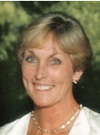
Former Administrator Cheryl Berkner Dies at 59
Cheryl McIntyre (McFate) Berkner, who enjoyed a 20-year career at Berkeley Lab in various roles, has died of cancer at the age of 59. She passed away on June 5 and was memorialized in private services on June 9. Prior to retiring, she was manager for administration in the Operations Directorate. Her husband, Klaus Berkner, has asked that, in lieu of flowers, donations be made to the Hospice of the East Bay.